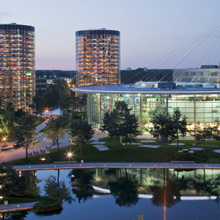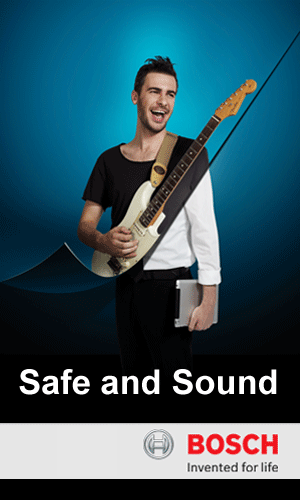 |
| The installation was DYNACORD P64's largest installation |
In the Autostadt Wolfsburg, the communication platform of the Volkswagen concern, everything revolves around mobility. Over 23 million people have visited the theme park and out-of-school learning centre since its opening in the year 2000, making it one of the most popular tourist destinations in Germany. The Autostadt is the world's largest automobile distribution centre and its automobile museum – the ZeitHaus – is the world's largest. With a multitude of cultural events staged there each year, the Autostadt is also an attractive venue for cultural pursuits, offering an ambience in which art, architecture and design combine to superlative effect in a 25-hectare landscaped park.
Work began on a technical upgrade to the Autostadt's sound reinforcement system around a year ago. The planning, project management and supervision were undertaken by the bureau of engineers Taube+Goerz GmbH under the direction of Dirk Narten, whilst the implementation was entrusted to Profi Musik. On-site responsibility was in the hands of Matthias Heinz and Jörg Lüdermann, Project Managers of the Autostadt; Jan Ohlhagen, Project Manager of Profi Musik; and Stefan Waltermathe, Project Manager of M-Akustik, the DYNACORD distribution partner and system specialist from Oldendorf in Hesse. The result is the world's largest installation combining the DYNACORD P64 with DYNACORD PROMATRIX DPM-4000 digital audio matrices.
In the course of the installation, the team was able to build on an already existing DYNACORD system: the Autostadt already possessed twenty DYNACORD ELA control centres plying the various brand pavilions and catering areas with background music and announcements. The objective, then, was to unite the individual amplifier banks in a redundant network conforming to the safety standards applicable to centralised and decentralised alarm and evacuation systems.
The central concern, therefore, was to create a combination of ELA system and audio matrix combining very high quality audio performance and a large number of channels with several centralised and decentralised priorities. The ideal system was soon identified: a DYNACORD P64 combined with a PROMATRIX DPM-4000 controller. "At the moment there is no other combination of ELA and matrix systems on the market that allows you to program individual functions over such a broad spectrum and combine them with one another," explains Mathias Vette, whose company M-Akustik was responsible as the system supplier of Profi Musik for the programming and system integration. "No other system permits control from within an ELA structure with such high audio quality."
For the implementation, the team relied on the DYNACORD PROMATRIX-4000 systems that were for the most part already installed. These were upgraded and each networked with DYNACORD P64 matrices driven by 116 DYNACORD DPA 4411 power amplifiers and 13 DYNACORD TPI 8 touch panels. The installed system now combines in its entirety 13 different buildings in a redundant configuration with 4 local priority, 3 superordinate priority, and 12 network-wide background programmes. From the master control centre, announcements can be assigned to the individual buildings with different priority levels. An identical system is installed in a second building to serve as a backup in case of system failure. Another unusual feature of the installation is the Autostadt's integrated studio, which plies visitors daily with 12 different music programmes simultaneously – with the highest audio quality.
The need for maximum quality as well as the giant size of the installation posed a number of challenges for the team. The existing system had to be partly replaced in order to bring the system structure into conformity with the standards. This had to be done, however, without interrupting daily operation. To ensure that each day the system distributing announcements and programme music remained operational, the installation team led by Nico Eishold and Jörg Olms had to work a large number of night shifts laying down the cable network. To proceed in the most economical manner possible, the planners therefore opted for a step-by-step implementation. The equipment in each building in turn was modified or else upgraded before being thoroughly tested. "Despite the size and complexity of the overall system, we were at no stage subject to constraints imposed by the programming environment," reports Mathias Vette: "We were able to implement the system throughout exactly the way we had planned it – and without constantly having to consult the manufacturer."




